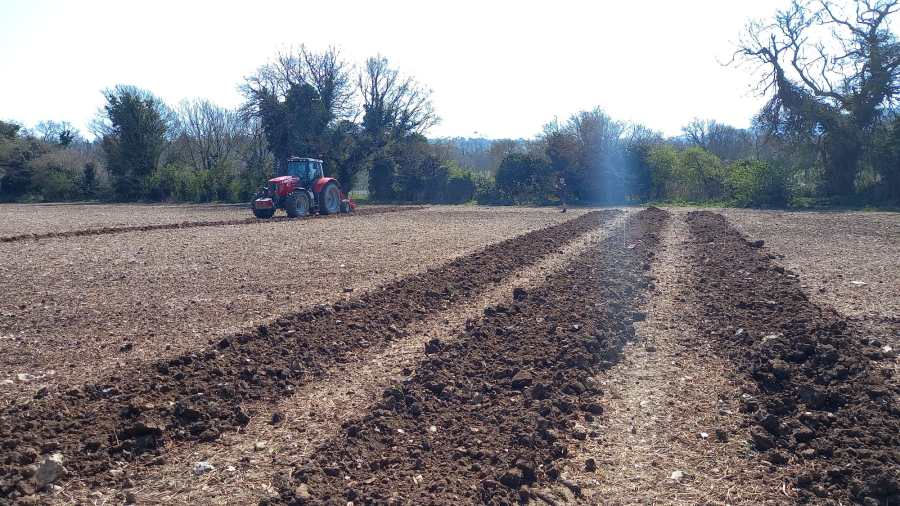Reducing soil disturbance during vineyard planting.
As environmental responsibility becomes a growing concern in the wine industry, viticulturists are keen to seek out more sustainable approaches to vineyard establishment and management.
Minimising soil disturbance while preparing the ground for planting is one option. However, it presents unique challenges when compared to conventional ground preparation methods.
Before starting any groundworks it is essential to identify and locate any subsurface features such as utility lines, land drains, and irrigation infrastructure. A thorough site assessment helps prevent damage and informs smarter planning.
Conventional ground preparation
Conventional ground preparation for a vineyard planting is not dissimilar to creating a 30cm-40cm fine seedbed for drilling an arable crop like maize. Ideally, this begins in the late summer or early autumn in the year before vine planting, depending on the soil profile.
This typically involves:
- Removing vegetation (e.g., grass or cover crop) in the plantable and headland areas via herbicide or rotovation.
- Deep tillage and subsoiling to break up compaction and improve root penetration.
- Power harrowing to create a fine tilth suitable for planting.
Challenges in minimising ground disturbance
Minimising ground disturbance during ground preparation is important for protecting soil health, controlling erosion, and preserving beneficial microorganisms, however it comes with several challenges:
- Weed and pest control: Reducing tillage or avoiding herbicides can make it harder to manage aggressive weeds before planting. Left uncontrolled, they will compete with the young vines for nutrients and water, potentially stunting development.
- Soil compaction: Young vines prefer well-aerated, deep soils for strong root development in those early years. Minimising disturbance offers less opportunity to break up compacted layers/hardpans. This could reduce root penetration, water infiltration and nutrient uptake, and negatively affect vine establishment.
- Poor drainage: Without significant reworking of the soil (such as deep ripping or regrading), existing drainage issues can persist. Poor drainage can lead to waterlogging, root diseases, and vine stress, particularly in heavy clay soils.
- Field variability: Natural soil variability across a site can affect vine vigour and yield if not corrected. Less aggressive preparation limits the ability to modify soils for uniformity (e.g., incorporating organic matter or fertiliser, redistributing soil).
- Erosion risk: During ground preparation where ground is not maintained with a ground cover, rainfall and wind can cause rapid soil loss on bare patches, particularly where there are slopes.
- Balancing short-term and long-term goals: There is a conflict between quick vine establishment (which sometimes benefits from traditional deep tillage) and long-term soil health goals. Minimising disturbance may mean slower early growth, but may contribute to better sustainability over the vineyard’s lifespan.
Minimising ground disturbance effectively
- Maintain existing vegetation: Preserve existing vegetation,especially native species, to protect soil structure. If you need to seed cover crops, use direct-drilling methods instead of full-field cultivation.
- Adopt targeted (strip) tillage: Instead of ripping or ploughing the entire field, deep rip only the future vine rows. Leaving the inter-rows undisturbed helps to maintain soil structure, microbial life, and organic matter.
- Apply soil amendments selectively: Rather than blanket applications of amendments like lime or compost, target areas based on soil test results. Banding techniques (e.g. directing compost into rows) help reduce disruption.
Improving efficiency while minimising ground disturbance
New innovations are making low-disturbance vineyard prep more practical. One example is the Viti-Till, a strip cultivation machine designed by Wagner Group specifically for vineyards, which VineWorks will be trialling in the UK in 2025. It prepares only the future vine rows, leaving inter-rows intact.
Early field results show that cultivating less than 50% of a field reduces carbon release, improves access in wet conditions, and limits weed emergence by preserving existing ground cover. These approaches are part of wider efforts to refine sustainable vineyard establishment techniques suited to UK conditions.
In conclusion
Minimising soil disturbance during vineyard establishment isn’t just a trend – it’s a practical step toward healthier soils, resilient vines, and long-term sustainability. Though it presents challenges – especially around drainage, weed control, and labour – targeted techniques and purpose-built tools are helping growers strike the right balance between immediate needs and environmental responsibility.

Strip till cultivation by Viti-Till, West Sussex




